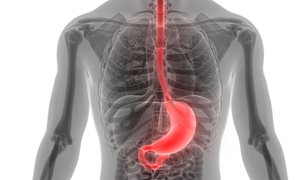31 January 2019
Most endoscopic resection esophageal strictures can be treated by endoscopic dilation, but a minority are found to be refractory or recurring after several dilation sessions. For these complex strictures, additional treatment modalities have become available, including endoscopic incisional therapy and stent placement, which can be selected on the basis of symptom duration and underlying cause.
This article presents a stepwise algorithm for the clinical management of patients with benign esophageal strictures, including a rational use of currently available treatment modalities.
Peter Siersema is member of theme Tumors of the digestive tract.
 In Gastroenterology Peter Siersema described the currently used treatment modalities for complex esophageal strictures, based on underlying cause and symptom duration, but also focusing on future treatment perspectives.
In Gastroenterology Peter Siersema described the currently used treatment modalities for complex esophageal strictures, based on underlying cause and symptom duration, but also focusing on future treatment perspectives.
Most endoscopic resection esophageal strictures can be treated by endoscopic dilation, but a minority are found to be refractory or recurring after several dilation sessions. For these complex strictures, additional treatment modalities have become available, including endoscopic incisional therapy and stent placement, which can be selected on the basis of symptom duration and underlying cause.
This article presents a stepwise algorithm for the clinical management of patients with benign esophageal strictures, including a rational use of currently available treatment modalities.
Peter Siersema is member of theme Tumors of the digestive tract.
-
Want to know more about these subjects? Click on the buttons below for more news.
Related news items

Electronic nose smells precursor of oesophageal cancer
5 March 2020 A portable electronic nose can effectively detect precursors of oesophageal cancer, reported by RIHS researchers Yonne Peters and Peter Siersema in the medical science journal GUT. This was demonstrated in an initial study involving more than four hundred patients. read more
Mohrmann Stipend for Bakker and Peters
12 December 2019 Tuesday 10 December, Esmée Bakker and Yonne Peters were awarded a Christine Mohrmann stipend. The grant – 5000 euros each – gives them an opportunity to spend time at another university, preferably one abroad. read more
Electronic nose detects bacterium that can cause stomach cancer
10 September 2019 OP Oost promotes innovative cooperation between companies and research institutions. read more
Barrett oesophagus
6 June 2019 In Nature Reviews Disease Primers Yonne Peters and Ali Al-Kaabi provided a global overview of Barrett oesophagus and outlined key open research questions. This primer covered epidemiology, disease mechanism, diagnose, screening, prevention, management, and quality of life. read more
Low risk of progression in persistent non-dysplastic Barrett’s esophagus
19 September 2018 In Clinical Gastroenterology and Hepatology Peter Siersema and Yonne Peters showed that patients with stable persistence of non-dysplastic Barrett’s esophagus have a low risk of malignant progression and may not benefit from routine endoscopic surveillance. read more
